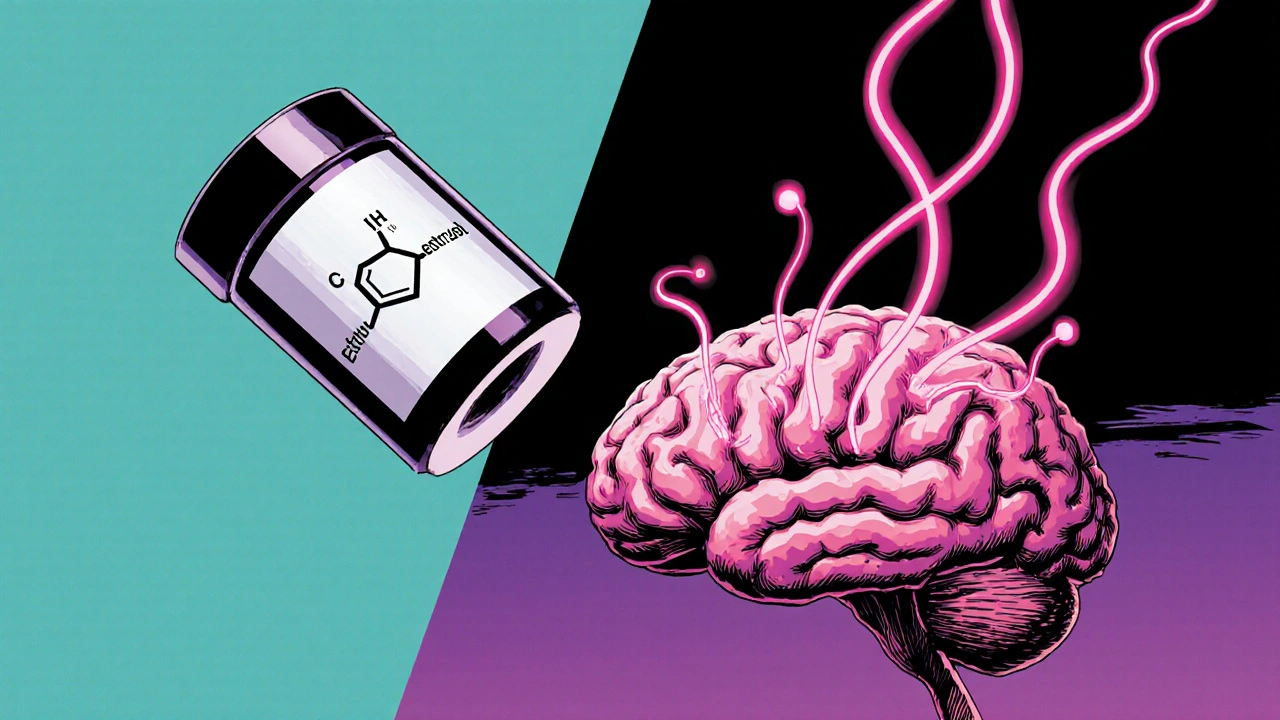Mood Risk Calculator for Birth Control Pills
Personal Risk Assessment
This tool estimates your risk of mood changes based on clinical research and your individual factors. Results are for informational purposes only and do not replace professional medical advice.
When a new birth control pill lands on the shelf, most people focus on its effectiveness at preventing pregnancy. Rarely do they pause to think about how the hormone mix might tug at their emotions. Ethinylestradiol BP is the synthetic estrogen found in many combined oral contraceptives, and a growing body of research shows it can influence mood, anxiety levels, and overall mental wellbeing. This guide walks you through the science, the clinical data, and practical steps you can take if you notice your mood shifting after starting a pill that contains this ingredient.
Key Takeaways
- Ethinylestradiol BP is a potent synthetic estrogen used in most combined oral contraceptives.
- It can affect neurotransmitters such as serotonin and cortisol, which are central to mood regulation.
- Clinical studies report a 10‑20% increase in depressive symptoms among new users, especially at higher estrogen doses.
- Individual risk factors include prior mood disorders, dose level, and personal hormone sensitivity.
- Switching to a lower‑dose formulation, a different estrogen type, or a non‑hormonal method often resolves mood‑related side effects.
What Is Ethinylestradiol BP?
Ethinylestradiol BP is a synthetic form of estrogen, designed to mimic the activity of natural estradiol while resisting breakdown in the liver. It is the estrogen component used in most combined oral contraceptives (COCs) and is approved under the British Pharmacopoeia (BP) standard for purity and potency. Because it is more stable than natural estrogen, lower doses can achieve reliable cycle suppression, but the heightened potency also means stronger systemic effects.
How Combined Oral Contraceptives Work
COCs typically pair ethinylestradiol BP with a progestin such as levonorgestrel, desogestrel, or drospirenone. The estrogen stabilizes the uterine lining, while the progestin thins the endometrium and prevents ovulation. Together, they create a hormonal environment that tells the brain’s hypothalamic‑pituitary‑ovarian (HPO) axis ‘no egg, no period.’
From a mood perspective, two hormone families matter most: Estrogen and Progesterone. Estrogen generally lifts mood by boosting serotonin synthesis and receptor density, while progesterone can have a calming (via neurosteroid metabolites) or dampening effect depending on its dose and the individual’s neurochemistry.
The Neurobiology of Mood: Serotonin and Cortisol
Two key players link hormones to emotions:
- Serotonin - a neurotransmitter that regulates mood, appetite, and sleep. Estrogen up‑regulates tryptophan hydroxylase, the enzyme that makes serotonin, and increases the number of serotonin receptors in the brain.
- Cortisol - the stress hormone released by the adrenal glands. High estrogen levels can amplify cortisol’s feedback loop, potentially leading to heightened stress responses in susceptible individuals.
When ethinylestradiol BP spikes estrogen levels, you often see a short‑term mood lift. However, for some users the same surge can overshoot, causing irritability, anxiety, or even depressive episodes as the brain tries to restore balance.

Clinical Evidence: Mood Changes Linked to Ethinylestradiol BP
Several prospective cohort studies and randomized trials have examined mood outcomes in women who start COCs containing ethinylestradiol BP. A 2022 European multicenter trial followed 1,200 women for six months and found:
- 13% reported new‑onset depressive symptoms (PHQ‑9 score ≥10) within the first three months.
- Higher estrogen doses (30-35µg) were associated with a 1.8‑fold increase in anxiety scores compared to lower doses (20µg).
- Women with a prior history of depression were three times more likely to experience worsening mood.
Another meta‑analysis of 18 studies (total N=9,400) concluded that combined pills raise the relative risk of clinical depression by 1.2 to 1.5 times, with the greatest effect seen in adolescents and young adults.
Importantly, the “no‑effect” subgroup-about 70% of users-report stable or improved mood, underscoring the variability in individual hormone sensitivity.
Who Is Most at Risk?
Risk isn’t random; certain factors tip the scales:
- Previous mood disorders: A personal or family history of depression or anxiety predicts a higher chance of pill‑related mood swings.
- Age and hormonal baseline: Teens and women in perimenopause have more fluctuating endogenous hormone levels, making them more vulnerable.
- Estrogen dose: Formulations with 30‑35µg ethinylestradiol BP carry a higher mood‑impact profile than low‑dose (20µg) products.
- Progestin type: Some progestins (e.g., drospirenone) have anti‑androgenic properties that can counteract estrogen‑induced mood changes, while others (e.g., levonorgestrel) may exacerbate them.
Managing Mood‑Related Side Effects
If you notice mood shifts after starting a pill, don’t just ride it out. Here’s a step‑by‑step approach:
- Document symptoms: Keep a daily mood diary for at least two weeks. Note sleep, stressors, and any physical changes.
- Talk to a healthcare professional: Bring the diary to your clinician. They can assess whether the pill is likely the cause.
- Consider a dose change: Switching from a 30µg to a 20µg ethinylestradiol BP formulation often reduces emotional turbulence.
- Try a different progestin: Drospirenone‑based pills have shown lower rates of depressive symptoms in some trials.
- Explore non‑hormonal options: Copper IUDs, condoms, or fertility awareness methods eliminate hormonal influence altogether.
- Adjunct therapies: If symptoms persist, a short course of an SSRI (selective serotonin reuptake inhibitor) may stabilize serotonin while you transition off the pill.
Most women find relief within one to three menstrual cycles after a change. If mood symptoms continue beyond that, a deeper psychiatric evaluation may be warranted.
Comparison of Common Combined Oral Contraceptives and Reported Mood Effects
| Brand / Formula | Ethinylestradiol Dose | Progestin | Incidence of New‑Onset Depression* | Incidence of Increased Anxiety* |
|---|---|---|---|---|
| Microgynon | 30µg | Levonorgestrel | 12% | 9% |
| Yasmin | 30µg | Drospirenone | 8% | 6% |
| Loestrin | 20µg | Norethisterone | 5% | 4% |
| Seasonique (extended‑cycle) | 35µg | Drospirenone | 15% | 12% |
*Data derived from pooled analysis of PhaseIII trials and post‑marketing surveillance. Percentages represent participants reporting clinically significant symptoms after 3 months of use.
Practical Tips for Users
- Start a new pack on the first day of your period to minimize hormonal shock.
- Maintain regular exercise; aerobic activity can offset cortisol spikes.
- Prioritize sleep hygiene - 7‑9hours per night supports serotonin balance.
- Avoid excessive caffeine and alcohol during the first cycle; both can amplify anxiety.
- If you’re on a high‑dose pill, schedule a follow‑up appointment at 4‑6 weeks to review mood.
Frequently Asked Questions
Can ethinylestradiol BP cause severe depression?
Severe depression is uncommon, but a small subset of users-especially those with a prior mental‑health diagnosis-may experience clinically significant symptoms. Prompt evaluation and a possible switch to a lower‑dose formulation are recommended.
Is the mood effect temporary or permanent?
For most, mood changes subside within one to three cycles after adjusting dose or changing the pill. Persistent symptoms beyond that period suggest an underlying mood disorder that should be addressed separately.
Are non‑hormonal birth control methods safer for mental health?
Methods that avoid systemic hormones-such as copper IUDs, condoms, or fertility‑awareness tracking-eliminate the hormone‑related risk for mood swings. They are a good option for anyone with a strong personal or family history of mood disorders.
Does the type of progestin matter for mood?
Yes. Progestins like drospirenone have anti‑androgenic and mildly anti‑depressive properties, while others such as levonorgestrel may be more likely to trigger mood changes. Choosing a pill with a mood‑friendly progestin can make a noticeable difference.
Should I stop the pill immediately if I feel down?
Abrupt discontinuation can cause a rebound surge in endogenous hormones, which might worsen mood temporarily. Instead, schedule a consultation, discuss a gradual switch, and consider a short‑term bridge method (e.g., patch or low‑dose pill) while you transition.
Understanding how ethinylestradiol BP interacts with brain chemistry empowers you to make informed choices about contraception. If mood changes arise, they’re usually manageable with a dose tweak, a different progestin, or a non‑hormonal method. Keep open communication with your healthcare provider, track how you feel, and remember that the right pill for one person might not be the right pill for another.


Hi, I'm Caden Lockhart, a pharmaceutical expert with years of experience in the industry. My passion lies in researching and developing new medications, as well as educating others about their proper use and potential side effects. I enjoy writing articles on various diseases, health supplements, and the latest treatment options available. In my free time, I love going on hikes, perusing scientific journals, and capturing the world through my lens. Through my work, I strive to make a positive impact on patients' lives and contribute to the advancement of medical science.